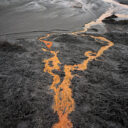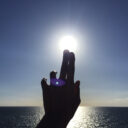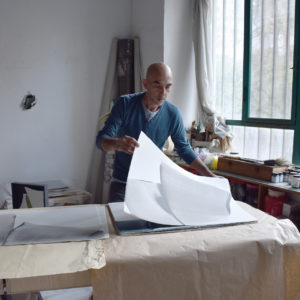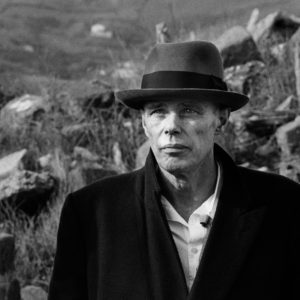di Giovanna Procaccini
Olafur Eliasson, artista di origini islandesi, nato nel 1967 a Copenhagen e stabilitosi con il suo studio-laboratorio a Berlino, il mondo, con le sue mostre, l’ha girato tutto, o quasi.
Le sue riflessioni sulle leggi fisiche che regolano l’Universo e sugli equilibri del nostro pianeta sono alla base del suo lavoro. Le sue installazioni interattive coinvolgono lo spettatore facendolo diventare parte integrante dell’opera stessa.
Eliasson crea in spazi chiusi arcobaleni artificiali, ambienti nebbiosi, pareti di muschio, spazi naturali con terreni rocciosi e ruscelli, fino a riuscire a far tramontare il sole nella Turbine Hall della Tate Modern di Londra con la celebre installazione The Weather Project del 2003: dietro uno schermo semicircolare sono sistemate 200 lampade che vengono raddoppiate, per completare l’intero disco solare, da uno specchio che corre lungo il soffitto della sala riflettendo i visitatori che guardano l’opera. Inoltre una leggera foschia viene riprodotta con macchine che generano vapore acqueo che nel corso della giornata si stratifica in nubi inattese.
Seeing Yourself Seeing (Vedere se stessi guardare) è il titolo di un’opera di Eliasson del 2001 ma è anche parte cardine della filosofia dell’artista. La percezione dell’opera d’arte è soggettiva ed è condizionata da una miriade di fattori personali; se poi, con essa, interagisce la percezione che l’osservatore ha di se stesso mentre fruisce dell’opera, mediante un sistema di specchi il cortocircuito è assicurato, e moltiplica una serie di significati soggettivi all’ennesima potenza.
La teoria della Gestalt (lo studio psicologico della percezione della forma) è stata oggetto di studi da parte di Eliasson sin dall’inizio della sua carriera e ha prodotto lavori come Less Ego Wall, del 2015: in un muro di frammenti di specchi a forma di diamante si alternano aperture triangolari, per cui lo spettatore vede un proliferare di riflessi, fra cui frammenti di se stesso, alternati a squarci che gli consentono di guardare attraverso, ridimensionando in tal modo la propria figura nel caos della visione collettiva.
Il continuo richiamo all’ambiente naturale presente nel lavoro di Eliasson non è puramente teorico. L’artista è attivamente coinvolto nella sensibilizzazione sui problemi del cambiamento climatico del nostro pianeta. Installazioni in spazi pubblici su questo tema sono state quelle di Ice Watch, realizzata per la prima volta a Copenaghen nel 2014, replicata a Parigi nel 2015, fino ai due grandi interventi site specific londinesi dello scorso dicembre: frammenti di iceberg staccatisi da un fiordo della Groenlandia vengono trasportati fino in città come se fossero il corpo di un reato e disposti in cerchio in modo da formare un orologio. L’inesorabile scioglimento del ghiaccio mostra il tempo che il ghiaccio dell’Artico impiega a sciogliersi a causa dell’innaturale innalzamento della temperatura esterna.
Un lavoro come questo esprime meglio di mille parole il rischio a cui il nostro pianeta è esposto e avvicina, in modo semplice ed efficace, l’arte contemporanea a un pubblico non museale.
Come anche la spettacolare installazione di Waterfall nei giardini della Reggia di Versailles. A coronamento dell’importante mostra allestita principalmente all’interno del palazzo, i comuni visitatori del parco sono stati accolti per tutta l’estate del 2016 da un’inaspettata cascata artificiale allestita all’imbocco del Grand Canal. La cascata era realizzata mediante una torre a tralicci sulla quale veniva trasportata l’acqua tramite una pompa e poi lasciata ricadere dall’alto. L’osservazione dell’interazione che la natura costruita, anche quella del parco, ha con gli agenti naturali quali vento, pioggia, condizioni della luce, spinge il visitatore a guardare la realtà da nuovi punti di vista, creandosene un’idea soggettiva. La sensazione di destabilizzazione nel ritrovarsi davanti a un pezzo di natura ricostruita con materiali artificiali è uno degli scopi che Eliasson persegue costantemente con le sue opere, nella convinzione che l’arte debba produrre dubbi più che fornire risposte.
Londra: Olafur Eliasson alla Tate Modern
A partire dall’11 luglio 2019 le opere di Olafur Eliasson saranno visibili in una grande retrospettiva nel tempio dell’arte contemporanea: la Tate Modern di Londra. Più di 30 lavori ripercorreranno la più che trentennale carriera dell’artista. Fra gli altri, è possibile ammirare l’arcobaleno nelle sale del museo con la ricostruzione della seminale installazione Beauty del 1993, in cui una miriade di particelle d’acqua vengono colpite da un fascio di luce che genera tutti i colori dell’iride, visibili però solo da una certa distanza e angolazione, facendo riflettere sulla effettiva complessità di semplici fenomeni naturali. Anche gli spazi esterni e l’atrio del museo saranno occupati dai lavori di Eliasson così come il Terrace Bar che proporrà uno speciale menù etico vegetariano elaborato dal team di esperti dello Studio Olafur Eliasson e quelli di Tate Eats.
Tate Modern – Londra
Olafur Eliasson: IN REAL LIFE
a cura di: Mark Godfrey e Emma Lewis
in collaborazione con: Studio Olafur Eliasson
11 luglio 2019 – 5 gennaio 2020
info: tate.org.uk
Little Sun
Little Sun è una lampada leggera e portatile, senza fili, che funziona a energia solare. Può essere ricaricata di giorno mediante un piccolo pannello solare posto sul retro e accesa all’occorrenza la sera per dare un numero maggiore di ore di studio o di lavoro in tutte quelle aree del mondo che non hanno accesso diretto alla rete di energia elettrica. Attualmente questo scopo è assolto per lo più da lanterne a kerosene le cui esalazioni sono altamente tossiche. Con Little Sun si può portare energia elettrica pulita anche in piccoli ambienti domestici.
Little Sun è un progetto fortemente voluto e perseguito con costanza da Olafur Eliasson anche mediante una campagna di crowfounding nel 2015 che è stata un vero successo e che ha fatto evolvere il progetto verso Little Sun Charge: un caricabatteria per cellulare che si ricarica ad energia solare. A partire dal primo progetto sviluppato in Etiopia nel 2012, oggi la Little Sun Foundation è attiva in 10 stati dell’Africa sub sahariana.
info: littlesunfoundation.org

Olafur Eliasson and the planet Earth. A Universe of inspiration.
Giovanna Procaccini
Olafur Eliasson, artist of Icelandic origins, born in 1967 in Copenhagen, and currently settled in Berlin with his study-laboratory, has traveled the entire world, or almost, with his exhibitions.
His considerations on the physical laws that govern the Universe and the balances within our planet are the foundations for his work. His interactive installations engage the audience by making them integral part of the work itself.
In closed spaces, Eliasson creates artificial rainbows, misty locations, musky walls, natural spaces with rocky terrains and water streams, even going as far as making the sun set in the Turbine Hall of the London Tate Modern, with his famous 2003 installation The Weather Project: behind a semicircular display two hundred lamps are placed, and to complete the solar disc, they are doubled by a mirror placed on the ceiling of the hall that reflects the visitors admiring the piece. Also, a light haze is replicated by means of steam machines, and during the day, it stratifies into unexpected clouds.
Seeing yourself Seeing is the title of a 2001 work by Eliasson but it is also a core concept in the artist’s philosophy. The perception of the work of art is subjective and influenced by several personal factor, moreover, if, by means of a system of mirrors, we add the perception the observer has on himself while admiring the piece, the short-circuit is guaranteed, and it multiplies to the nth degree a series of subjective meanings.
The Gestalt theory (the psychological study on the perception of shapes) has been object of studies by Eliasson ever since the beginning of his career, and it produced works such as the 2015 Less Ego Wall: a wall made of diamond-shapes mirror shards is alternated by triangular opening, so the spectator can see a myriads of reflections, including his own, alternated by openings that allow him to see through, reducing, in this way, his own figure among the chaos of the collective vision.
The continuous references to the natural setting that are present in Eliasson’s works are not merely theoretical. The artist is actively involved in raising awareness on the issue of the climate change in our planet. On these subjects, the installations in open spaces such as Ice Watch, first realized in 2014 in Copenhagen, and repeated in 2015 in Paris, and the two site specific interventions in London, last December: Iceberg shards detached from a fjord in Greenland have been moved right into the city, as if they were bodies of evidence, and have been placed in a circle, to form a clockface. The ice relentlessly melting represents the time the Artic ice takes to melt because of the unnatural rising of the external temperature.
Such a work can show us, more effectively than a thousand words, the risk our planet is living, and it bring closer, in a simple and effective way, contemporary art and a more casual audience.
There is also the magnificent Waterfall installation in the gardens of the Versailles Palace. As a crowning element for the important exhibition, set mainly inside the mansion, the ordinary visitors of the park have been welcomed, during the entire summer of 2016, by an unexpected artificial waterfall, realized at the entrance of the Grand Canal. The waterfall has been realized by means of a trellis frame tower on which the water was carried with a pump and then later let fall from above. Witnessing the interaction between the fictional nature, even the one in the park, and the natural elements such as wind, rain, light, makes the observer see reality from a new perspective, creating a subjective impression of it. The destabilizing sensation of finding yourself facing a piece of nature built from artificial materials is one of the goals that Eliasson constantly aims at with his works, following his belief that art has to produce doubts more than giving answers.
London: Olafur Eliasson at the Tate Modern
Starting from July 11th, 2019, Olafur Eliasson’s works will be displayed in a big retrospective in the temple of contemporary art: the London Tate Modern. More than thirty pieces will retrace the more than thirty years long career of the artist. Among others, it is possible to admire the rainbow in the museum’s halls with the reconstruction of the seminal 1992 installation Beauty, where myriads of water particles, hit by a ray of light, create all the colors of the rainbow, only visible at a certain distance and angle, and make us ponder on the effective complexity of simple natural phenomenon. Even the interior spaces and the museum’s atrium will be occupied by Eliasson’s work, as well as the Terrace Bar, which will feature a special ethic vegetarian menu, created by the team of experts lead by the Olafur Eliasson Studio and by Tate Eats.
Tate Modern – London
Olafur Eliasson: IN REAL LIFE
edited by: Mark Godfrev and Emma Lewis
in collaboration with: Olafur Eliasson Studio
July 11th, 2019 – January 5th 2020
info: tate.org.uk
Little Sun
Little Sun is a light, portable and wireless lamp, that runs on solar power. It can be recharged by day through a little solar panel placed on the back, and it can be turned on, when needed, by night, to provide more hours for study or work in all those areas in the world where there is no direct access to the electricity network. Currently, this task is fulfilled by kerosene lanterns, whose exhalations are highly toxic. With Little Sun you can bring clean electricity even in small domestic environments.
Little Sun is a project strongly wanted and pursued with perseverance by Olafur Eliasson, even though a very successful crowdfunding campaign in 2015, which made the project evolve into Little Sun Charge: a smartphone battery charger that runs on solar power. Since the first project, developed in Ethiopia in 2012, today the Little Sun Foundation is active in ten states in sub-Saharan Africa.
info: littlesunfoundation.org








No Comments